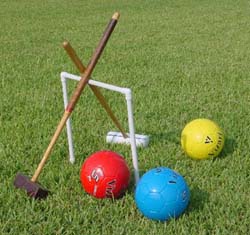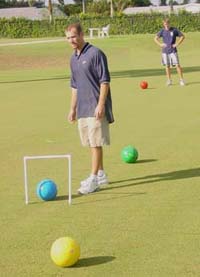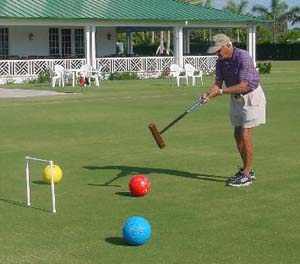
|
Back to |
| The Front Page |
| The Game |
|
Toequet and Malletball: the sport's newest
rough turf alternative by Bob Alman with Denny and Bret Ridgway photos by Bob Alman and the Ridgways Posted May 15, 2003 |
|
|||||||||
Toequet is a new game now being played by some youth groups in South Florida and by the family and friends of Bret and Denny Ridgway of Terre Haute, Indiana. Instead of croquet balls, soccer balls are used, with oversized wickets to match. Instead of striking the balls with a mallet, the balls are propelled by being kicked - at least that was the original idea of the inventors. But now the experimenters at the National Croquet Center have discovered an equally interesting application of the equipment: "Malletball," using regulation three-pound mallets. It all sounds extreme, but it makes good sense. Here's how it happened.
Indiana is a big hole in the croquet map for the official sport of croquet. But plenty of people there play traditional backyard croquet, including Bret Ridgway and his father Denny. The problem is the quality of the lawns. Denny relishes the memories of backyard croquet as a child and with his own children when they were growing up. But at family get-togethers, Denny was unsatisfied with the quality of the lawns available at picnic sites where the reunions were held.
So after Denny Ridgeway retired a few years ago from Columbia House, he started to seriously address the problem: How to play a good game of croquet on bad lawns for his annual family reunion on Labor Day weekend.
The big idea: everything is bigger
The "big idea" of course, came first: to magnify all the elements of the game so that a thick grass or otherwise variable surface became less a problem. After that, the problem of the wickets and ball had to be considered.

|
| Conventional croquet wouldn't be much fun on this typical expanse of St. Augustine, with the balls sinking deep into the long, thick and spongy grass. But the soccer balls - whether kicked or struck with a mallet - sail right along the top of turf, enabling a surprisingly satisfying game. |
Next came the wickets. "We tried about twelve difference wicket designs", Denny reports, "before we came up with the lightweight PVC piping. Our first trial was with wooden stakes driven into the ground. They would break, and then if there's no top, you can't tell if you scored. Metal rods driven in the ground with PVC on top worked a little better, but that rig broke too easily. We went to a plastic molding company to see what they could do for us, and they finally offered something that cost $28 a wicket. Finally it was PVC. The clincher was safety: We wanted something sturdy, easy to assemble, and lightweight, something that would break away easily without injuring any one." It had to be PVC.
The stake, of course, was simple: PVC with colored bands of tape to show the rotation of the balls.
The Toequet Company is formed
All the elements of the Toequet set came together around the middle of 2002, when Denny, Bret and a couple of friends formed The Toequet Company and the first sets were manufactured. In the fall of 2002, their own website followed.
So why haven't you heard of Toequet before? "We have no marketing channels," Denny said, "nowhere to get the word out, so far, except you people." Meaning, of course, the National Croquet Center.

|
| Chris Rainwater, intramural sports director at Palm Beach Atlantic University, contemplates his wicket shot.. Rainwater was an early champion of the game in South Florida and regularly schedules student groups to play it at the National Croquet Center. |
It's a serious question that calls for a good answer: First, it expands the range of our youth programs here at the National Croquet Center. Anything that attracts attention to the Center and the sport is good for croquet. That's one answer. A second and perhaps more resounding answer was discovered by accident quite recently.
Is there a future for Malletball?
A well-known local player named John Ryan was one of Toequet's detractors. The game annoyed him. "It's not croquet," he said, "and this is the National Croquet Center." But he was good-humored about it, and it became a standing joke between us. Then one day when I was cleaning up the Harpo Marx Fairway after a Toequet match, he approached as I was striking one of the soccer balls with a mallet. I had noticed that the relative weight of the ball and the three-pound mallet interacted well together; it was possible with concentration to get a reliably accurate hit with the mallet on the soccer ball.
Soon I was playing a game of "Malletball" with John Ryan - the first such game ever played, by the rules of Golf Croquet. The game took only 20 minutes or so, and I think we were both surprised at how much fun we had. I won by a whisker, 4-3. John and I agreed it was a pretty good game - better than the kicking version, for us.
You don't need binoculars to follow the action

|
| Archie Peck, Director of Croquet at the National Croquet Center, demonstrates perfect form and characteristic accuracy in a super-court demonstration of Mallet Toequet in front of the clubhouse |
Clearly, we're hooked on this novelty equipment, whether the balls are kicked or struck with a mallet. In the meantime, their equipment has only fueled the Ridgways' passion for the game. They play a couple of times a week in the park with a few friends. And the next generation of Ridgways are being introduced to the game at their annual reunions.
Now you can play in almost any park
Their ideal course is in a local park, with plenty of space. "The bigger the court, the better for me," Brets says, "because I have a strong kick. I like to play on a court 75 paces wide and 150 paces long." Usually Bret and his friends set up without fixed boundaries and replace the ball where it goes out - a road, for example - without penalties.

|
| Both Toequet and Malletball are ideal family games, and they are both being played here on "family day" at the National Croquet Center in West Palm Beach. |
Do they ever expect to make money on their invention? "Heavens, no," Bret says. It's a hobby for me, and for my dad, it's his passion, since he retired."
What does Denny see in the future of Toequet? He won't predict that the novelty game will ever be as popular as the Hula Hoop or the Frisbee. But he admits, "It would be great to see people all over playing a game that was my idea."
I also think that would be pretty great. Whatever happens, we'll continue to sell the Ridgways' invention to visitors to the Center and our website, and we'll continue to recommend it to recreation directors and as a great gift for croquet players to give their turfless friends and relatives - along with some heavy mallets, perhaps, so they can play "Malletball" as well as Toequet.
[See the "official" Toequet rules as played at the National Croquet Center:]